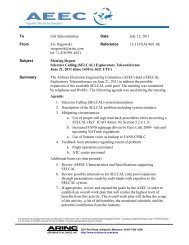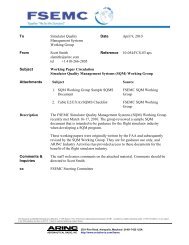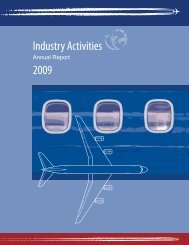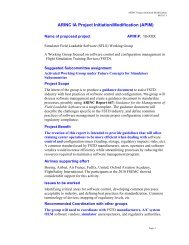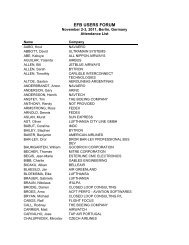2013 FSEMC Program - Aviation Committees - AEEC - AMC
2013 FSEMC Program - Aviation Committees - AEEC - AMC
2013 FSEMC Program - Aviation Committees - AEEC - AMC
You also want an ePaper? Increase the reach of your titles
YUMPU automatically turns print PDFs into web optimized ePapers that Google loves.
Edwin A. Link Award"Ed" Link was born in 1904 in Huntington, Indiana, but moved in 1910 toBinghamton, New York, where his father purchased a bankrupt music firm. It washere Ed would begin and develop his career as (to quote his friend Harvey Roehl)a "backyard inventor in the finest American sense."In his early twenties, at considerable expense and some risk, he obtained hispilot's license. While struggling to become a pilot, he began tinkering with parts oforgans at his father's factory, trying to develop a training device so that pilotscould start learning to fly safely and inexpensively without leaving the ground.Initially his trainer, although successful, was seen as a toy and relegated to thestatus of fairground ride.In the mid-1930's, after a series of air accidents, the Army AirCorps ordered six of Link's instrument trainers to enhance itspilot training program. Once public attention had been drawnto this practical device, orders for more came from all over theworld. Ultimately Link's invention led to the development of thewhole field of flight simulation. With the help of his wife,Marion Clayton Link, whom he had married in 1931, Ed ran ahighly successful enterprise, Link <strong>Aviation</strong>, Inc., throughoutWorld War II and until he sold the company in 1954.Thereafter Ed's skills and attention focused on underwaterarchaeology and exploration. In this, his wife Marion became his partner in research, and, with their twosons William Martin and Edwin Clayton, they undertook a number of voyages. During these years Edworked constantly to improve diving equipment in order to allow divers to go deeper, stay longerunderwater, explore more safely and efficiently, and return to the surface with less risk. On one of thesea voyages in 1973, during a routine dive in a submersible, the Links' younger son Clayton and hisfriend Albert Stover were killed. In a very moving statement to the press, Ed expressed his convictionthat their death had not been in vain, but had identified problems that must be solved in order to meet thechallenge of safer underwater exploration.Mr. Link continued actively exploring, tinkering, writing and generally enjoying his many interests untilvery shortly before his death in 1981. His was an unusually generous spirit: not only did he give tirelesslyof his time and energy; he also donated financially to many foundations, scholarships and charitablecauses.<strong>FSEMC</strong> is pleased to honor Edwin A. Link by selecting one individual each year for significantcontribution in flight simulator support. On behalf of ARINC and <strong>FSEMC</strong>, we gratefully acknowledge andoffer our thanks to the following individuals and organizations for their support of this award:• Marilyn Link, Special Advisor, The Link Foundation• The Link Foundation Board of Trustees• L3 Communications’ Link Simulation & Training• Binghamton University• Roberson Museum and Science CenterP-10



